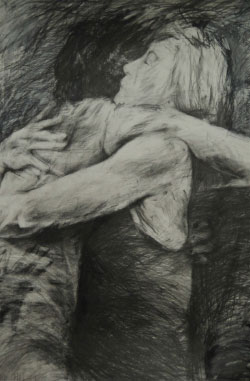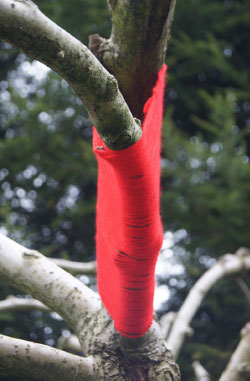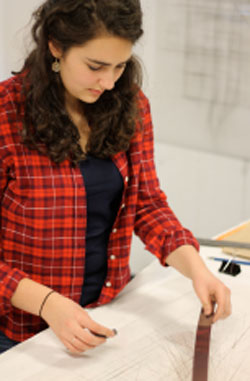Artist expresses spirituality through creations
An interview with Diana Hiebert
As a fourth-year art and design major at Trinity Western University, and exhibition and public activities manager at The Reach Gallery Museum Abbotsford, B.C., Diana Hiebert is both exploring her own creative ability and empowering community artists to do the same. She participated in last year’s Sand and Polish: Making Things New exhibition, organized by Artisan Church in the Vancouver Public Library’s Moat gallery, and is currently working toward her graduation exhibition at TWU.
Tell me a bit about yourself.
I recall very clearly my joyful conversion experience when I was a young child. When my family moved [from Mississauga, Ont.] in 1998, South Abbotsford (B.C.) MB became my home church, and I graduated from Mennonite Educational Institute in 2010. Recently I have revisited my Pentecostal roots.
When did you figure out that you were an artist?
I think I’ve always been drawing and painting and thinking creatively, ever since I was young. The environment has been a source of refuge and inspiration. In addition, my parents saw the importance of cultivating a Christian imagination and introduced me to many art forms as a child.
However, as I began to pay attention to the world around me, I wondered, “What tangible good can an artist do a hurting world?” I couldn’t see how I could erase injustice or draw new paths to heal suffering with my art. That question really shook the core of who I am – and still does every once in a while.
I love when contemporary artists cry out against the overlooked-and-sometimes-terrible realities of an imperfect world. This is encouraging, because it seems like these artists have a deep desire to redeem injustices by creating a space for “visual dialogue” – an exchange of ideas with viewers. Artists, including myself, can choose to be idea-shapers.
What do you create and why?
During my university studies, my artwork has been, often unconsciously, a means of expressing my spirituality. Art has helped me grapple with difficult issues.
Last year, I felt compelled to explore compassion, joy, and healing – themes not as frequently investigated in the current art culture. I am still seeking understanding and expression in this area in the midst of this tension.
I created an abstract work entitled “Hyssop” – essentially a large, unstretched canvas piece. The biblical narrative became a natural source of inspiration [on healing].
In the book of Exodus, the Israelites dipped hyssop in blood and used it to mark their doorways against the threat of Death. The medicinal properties of the plant hyssop symbolize restoration and hope. This idea informs this piece’s first layer (now hidden by many layers of paint and graphite) depicting a figure in anguish.
Recently, I have also completed “Inscapes” inspired by insights gleaned from 19th-century poet Gerard Manley Hopkins. In this environmental art installation, I bound red yarn on tree branches and created other knitted “garments” for other aspects of the environment.
My artwork is purposely steeped in symbolism of binding, and suggests regenerative healing of humanity and the earth. Lately, I’ve also explored knitted sculpture as I continue to wrestle with ways to interpret compassion and healing in a postmodern context.
And how does your Christian background influence your work?
It informs who I am. It’s an ongoing journey. My Christian heritage has reinforced the importance of relationships and the value of belonging in community.
I want my art to be a dialogue with the viewer: I want to start a conversation, and cultivate community. I am also passionate about reinforcing a more positive dialogue between the Christian community and the wider cultural community via visual arts.
Themes such as suffering, compassion, and healing are associated with Christ the wounded healer, and are certainly relevant to an anxious generation looking for rest and revitalization.
What mediums are your favourites?
I like to experiment in many different media, but my favourites at the moment are drawing and installation work.
Tell me a bit about your summer job at The Reach.
In 2012, as cultural programs assistant, I worked in design and leadership on [among others] the Art Car program – featuring collaborative community design on a vehicle. A lot of adults who participated in Art Car commented on how therapeutic the project was for them. This has inspired me to investigate larger-scale collaborative projects with people from the community.
In 2013, I’ve been helping to design shows. It has been a privilege to handle the work of local artists as well as pieces from the National Art Gallery and Canadian War Museum in Ottawa.
Has it been challenging to transition from Trinity Western to a public art gallery? What are some of the tensions you experience?
In terms of artistic training at TWU, I feel prepared to work in both Christian and non-Christian contexts. Trinity teaches me what the art world is – contentious issues and all. It’s my job, as a Christian university student, to grapple with them and develop an informed perspective.
It’s always healthy to be challenged to think about how to integrate faith in all of life. It’s important to remember that people are image bearers. Everyone deserves to be respected and have their value acknowledged in whatever environment – Christian or non-Christian.
What other projects have you been part of at The Reach?
I worked with Amy Loewen on her Illuminating Peace exhibit last fall. Her work is both interesting and beautiful because it explores peace and the world community. The artist created a huge lantern and wove into it positive words such as love and compassion in different languages. Her work challenged viewers to consider peace.
What does the future hold for you?
I would love to continue making artwork and develop a career as an artist. However, I am also interested in curatorial work, architecture, and other types of design. The other day, I filled half a sketchbook with ideas. There are so many possibilities.
—Paul Esau interned with the communications department at the Canadian Conference of MB Churches.




1 comment
Thanks for your reflections! I am so inspired by how Liberal Arts Education has transformed you in such a personal and tangible way within and through arts. Beautiful.